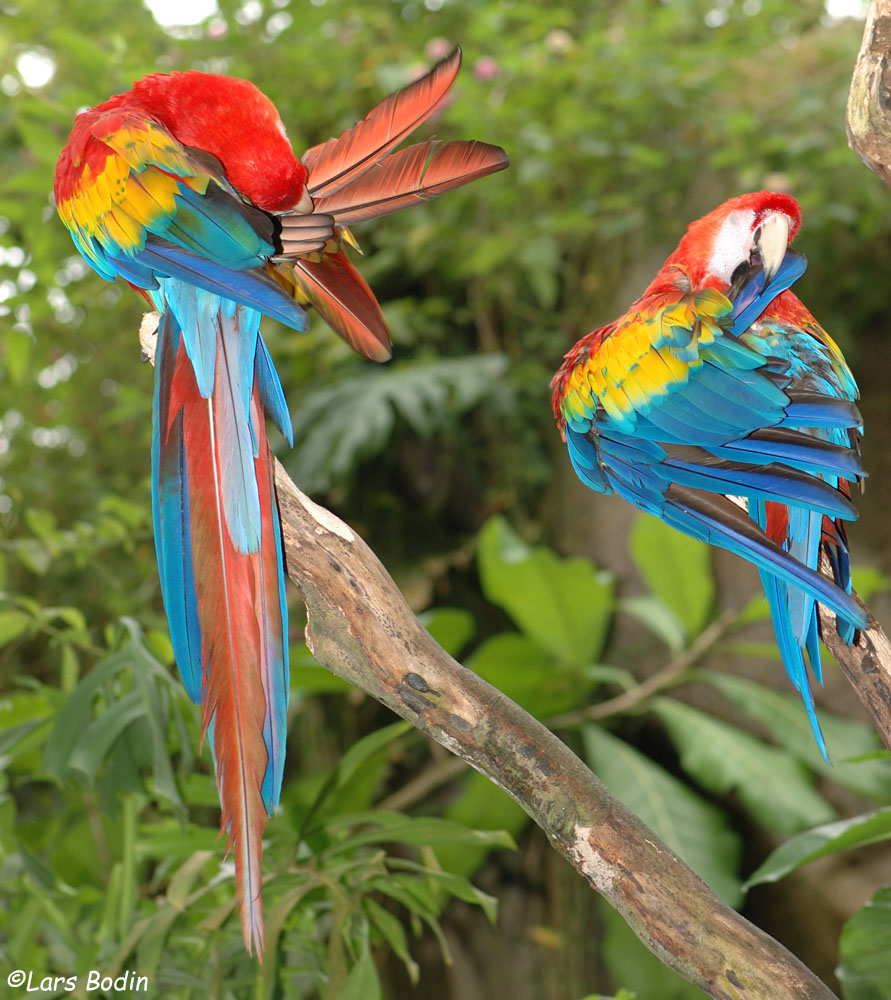Ara macao – Scarlet Macaw
The Scarlet Macaw is a large colourful large Neotropical parrot. Their beautiful colors have made them popular as pets and among breeders and they are common in captivity all over the world, especially in the Americas. This species was first described by the swedish zoologist Carl Linnaeus in 1758, who categorised it as Psittacus macao; it was later moved to the Ara genus.
They can be very noisy and they love to chew on everything with their big powerful beak; leave a macaw in a room without supervision and you can expect to see all sorts of mayhem when you get back! Make sure the room used for out-of-cage time do not contain anything dangerous or poisonous for parrots!
Scarlet Macaws are monogamous and will stay together with their partner for the rest of their life; in flight the pair can be seen flying in close formation above the forest canopy.
Some macaws are reported to be more than 75 years old but the lifespan is usually 45-60 years in captivity with good care.
Like the other large macaws the Scarlet Macaw should have plenty of space to exercise and fly; the optimal solution would be training the birds for free flight but this require a skilled trainer! Alternatively the aviary should be 15 m long and caged birds should have several hours out of the cage each day in a large room. The aviary or cage should be constructed of strong materials – the powerful beak can easily destroy the wire mesh or metal bars used in cages for smaller parrots!
Provide robes and branches for climbing and plenty of bird safe chew toys.
Their habitat covers a wide range and as such they are listed as Least Concern by the IUCN Red List. Even though they are currently not threatened, there seem to be a decline in population due to habitat loss, fragmentation and wild bird trade.
Notice that the Scarlet Macaw is listed on CITES Appendix I and EU Annex A!
Description
The plumage is general red with blue rump and tail coverts. Median and secondary wing coverts are yellow; sometimes with a green tip. The tail is red with blue tip and very long. The beak is large; the upper mandible is horn coloured with black sides at base, the lower mandible is grey/black. Yellow eyes. Large patch with bare white skin covering area from base of the beak to and around the eyes; the bare skin have thin feathered red stripes but much less than on the Red-and-green Macaw; on some birds these feathered red stripes are barely visible or missing.
Juveniles are similar to the adults but with shorter tail; grey eyes; lower mandible is a paler grey.
Size: 85 cm
Weight: 1060 – 1123 g
Some may confuse the Scarlet Macaw with the Red-and-green Macaw as they are both red in general; however the Red-and-green Macaw is larger, has a darker red colour, green middle wing coverts and the red feathered stripes in the bare white facial skin are more noticeable.
Video: Copyright © Avi Birds – please also visit avibirds.com for more bird related information.
Subspecies
Two subspecies are recognized:
- Ara macao macao (Linnaeus, 1758): Costa Rica to Bolivia and central Brazil
- Ara macao cyanopterus (Wiedenfeld, 1995): south-eastern Mexico to Nicaragua. Similar to nominate species but larger in size; median and secondary wing coverts tipped with blue.
Habitat
Scarlet Macaw is widespread in the southern Central America and northern South America; it inhabits a large range from south-eastern Mexico to Colombia and Amazonia.
They are usually found in lowland rainforest up to 500 m but locally up to 1000 m.
Diet
They mainly feed on large nuts and fruits from various palms but also flowers and nectar.
Some of the digested plant parts contains poisonous; for this reason macaws will gather at special clay banks where they will lick the clay, that helps digestion and neutralize the poisons. Many parrot species in South America regularly visit these clay banks.
Aviculture
The large macaws are in general more difficult to breed in captivity than many of the smaller parrot species, but several breeders have had success with breeding Scarlet Macaws in captivity. They can be very aggressive during the breeding period and will warn of trespassers with loud screams.
The nest box should be about 40 x 40 x 125 cm
The clutch usually contains 2-4 eggs that are incubated for about 24-26 days. The chicks fledges 90-105 days after hatching. The chicks will stay with their parents for about a 1-2 years; the adults will not start breeding again until the chicks are independent.
Taxonomy
- Order: Psittaciformes
- Family: Psittacidae
- Genus: Ara
Synonyms
- Danish: Lyserød Ara
- English: Scarlet Macaw, Red-and-yellow Macaw, Red-breasted Macaw, Red-yellow-and-blue Macaw
- French: Ara macao, Ara rouge
- German: Arakanga, Hellroter ara, Scharlachara
- Portuguese: Arara-boliviana, Araracanga, Arara-canga, Arara-macau, Arara-piranga, Arara-vermelha, Arara-vermelha-pequena, Macau
- Spanish: Guacamaya Macao, Guacamaya Roja, Guacamayo Macao, Guacamayo Rojo, Guacamayo Rosado, Guara roja, Lapa Roja
- Scientific: Ara macao
IUCN Red List

https://dx.doi.org/10.2305/IUCN.UK.2016-3.RLTS.T22685563A93079992.en
Downloaded on 9 July 2021





